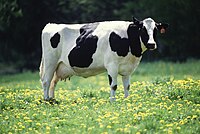
Photo from wikipedia
The present study aimed to evaluate two rotational stocking intervals (GI) over three consecutive grazing periods on forage productivity, crude protein and neutral detergent fibre of Urochloa brizantha cv. Marandu… Click to show full abstract
The present study aimed to evaluate two rotational stocking intervals (GI) over three consecutive grazing periods on forage productivity, crude protein and neutral detergent fibre of Urochloa brizantha cv. Marandu pastures, and the subsequent impact on milk production. Grazing treatments were (1) fixed rest period at 30 days (30-FG) and (2) grazing interval when canopy was intercepting 95% photosynthetically active radiation (95-LI). Eighteen multiparous Holstein × Zebu cows (548 ± 61.0 kg bodyweight, BW) and 70 ± 18.1 days in milk were used. Experiment lasted for 99 days (i.e. 33 days per period). Nine cows with similar milk production and BW were randomly allocated to each GI treatment balanced on milk production and BW. The adjustment of carrying capacity per paddock was made aiming to achieve a post-grazing residual height of 20 cm. For this, additional dry Holstein × Zebu cows (averaging 550 kg BW) were added and removed from the paddocks according put-and-take technique. Data were statistically analysed considering field sites as block (n = 2), GI (30-FG vs 95-LI), periods (three consecutive) and interaction GI × periods. Interactions occurred between GI and periods for pre- and post-grazing height (P ≤ 0.05). Greater pre-grazing height was observed for 30-FG (P < 0.01), but post-grazing height was greater (P < 0.01) for 30-FG only in the third period. GI for treatment 30-FG was ~6 days longer (P = 0.01) than that for 95-LIand light interception was greater (2%) for 30-FG. Total forage, stem and dead material mass per area were greater (P < 0.01) for 30-FG than 95-LI. However, stocking rate was 11.3% greater (P = 0.02) for 95-LI than 30-FG. In the pre-grazing period, 95-LI had greater (P < 0.01) proportion of leaves and a greater leaf : stem ratio, whereas neutral detergent fibre concentration tended to be lower (P = 0.08) and crude protein concentration greater (P < 0.01) in 95-LI than in 30-FG. Daily milk productivity per area and its components were 16–28% greater (P < 0.01) for 95-LI than for 30-FD. These results suggest that GI of Marandu grass determined by light interception at 95% (95-LI) enabled the reduction of GI, improved forage nutritive value and increased milk productivity compared with a fixed 30 days (30-FG) of rest.
Journal Title: Animal Production Science
Year Published: 2017
Link to full text (if available)
Share on Social Media: Sign Up to like & get
recommendations!